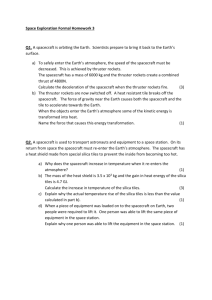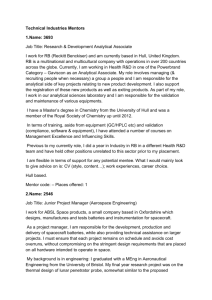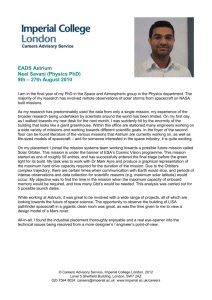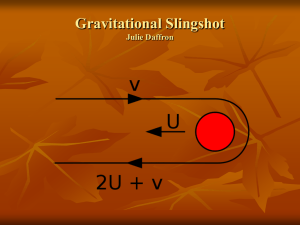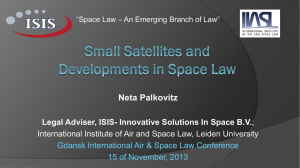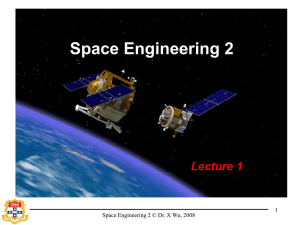SPADE LEO Flight Test Report
advertisement
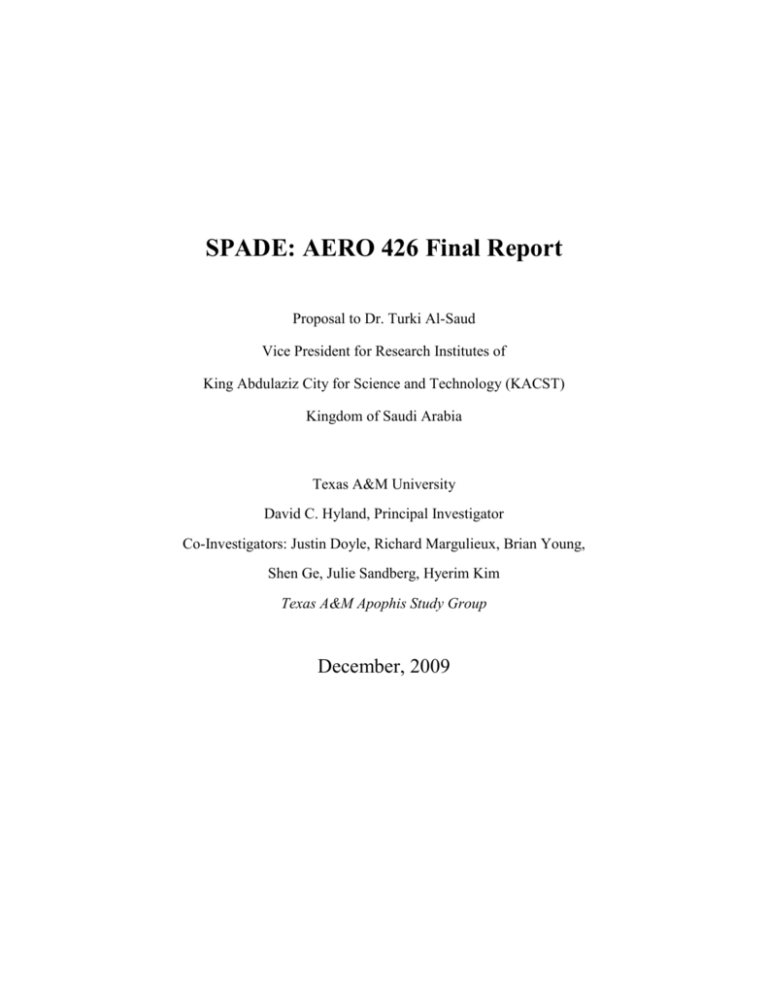
SPADE: AERO 426 Final Report Proposal to Dr. Turki Al-Saud Vice President for Research Institutes of King Abdulaziz City for Science and Technology (KACST) Kingdom of Saudi Arabia Texas A&M University David C. Hyland, Principal Investigator Co-Investigators: Justin Doyle, Richard Margulieux, Brian Young, Shen Ge, Julie Sandberg, Hyerim Kim Texas A&M Apophis Study Group December, 2009 I. Mission Statements and Requirements A Low Earth Orbit (LEO) flight experiment will validate the operation of the Surface Albedo Treatment System (SATS) in a space environment. This experiment, the Static Preliminary Albedo Demonstration Experiment (SPADE), will serve as the final risk reduction test for the AEMP. During this experiment, an albedo change mechanism will modify the albedo of a test surface.The mission requirements are as follows: 1) The satellite must verify characteristics of the tribo-dispenser system: a. Necessary dispensing cone angle b. Flow and powder deposition rates c. Coverage efficiency d. Albedo change of the test object. 2) The total mass of the spacecraft must not exceed 50 kg. 3) The launch shall occur no later than December of 2011. 4) Design margins for power and mass must be at least 30%. II. Spacecraft Design The SPADE design is a cube-shaped spacecraft 40x40x40cm. A static, flat SATS test surface is attached to the satellite and exposed to the LEO environment. The simple architecture requires no deployment of any segments. For the purposes of this design the launch vehicle is assumed to be the Minotaur IV or an equivalent launch vehicle, capable of using an ESPA 24 payload adapter. Power for the spacecraft bus will be provided by solar panels and secondary batteries, while the SATS payload will operate from a distinct primary battery. Torque rods, magnetometers, and coarse sun sensors will be used for attitude control. The communications scheme will utilize a store-and-forward architecture, and using an omnidirectional monopole antenna, CubeSat-class UHF transceiver, a GPS beacon will be integrated to aid acquisition and tracking. A CCD imager will capture the SATS deposition process, using sunlight for illumination. The frames will be analyzed by TAMU Apophis Study Group (TASG) on the ground to refine tribodeposition models in the space environment. III. Albedo Experiment Design To simulate the natural charging of the sunlit Chondritic asteroid surface, the SATS test surface will be constructed as a parallel plate capacitor. The surface will have three regions, each of a different roughness, arranged in parallel strips, to test the effects of roughness on particle curing and adhesion. The test surface area of 0.22 m2 is consistent with the assumed volume constraints; this will need to be reassessed given a final vehicle selection. 2 Prior to dispersion, the albedo changing particles (ACPs) and pressurant will be stored in separate spherical tanks near the tribo-dispenser. As indicated in Error! Reference source not found., the tribo-dispenser will be mounted opposite of the test surface, with the barrel angled toward the surface. The particles will spread out in a cone with a circular cross section. Imagery will be collected as the particles are released, electrostatically attracted to, cured, and adhered to the surface. The tribo-dispenser requires 95 W of power for the duration of the experiment. Detailed SATS parameters for the SPADE mission are described in Table 1. Figure 1. SPADE Satellite Bus Table 1. Tribo-dispenser Components Characteristic Pressurant Gas Tank Diameter ACP Canister Diameter Ionization Tube Average Diameter Ionization Tube Length Size (cm) 15 10 0.2 33 The estimated mass budget of the tribo-dispenser is summarized in Table 2. These values are largely based on commercially available tribo-charging equipment. The mass of the powder was calculated to cover 4 m2 with 100μm PFTE. The design here assumes PFTE for the ACPs, nylon 3 for the dispenser interior, and nitrogen as the pressurant. Power requirements are discussed in a later section. Table 2.Tribo-dispenser Estimated Mass Budget Characteristic Mass of the powder Powder canister Pressurant gas Pressurant tank Tribo-dispenser Control electronics Tubing and valves Total Mass (kg) 0.7 0.3 0.1 0.3 0.6 0.4 0.5 2.9 IV. Launch Vehicle and Orbit Requirements The design process assumed that the spacecraft will be launched as a secondary payload on an ESPA 24 payload adapter ring. This payload adapter allows six small, cube-shaped satellites to be launched into orbit simultaneously. Each spacecraft shall be no larger than 24 in x 20 in x 18 in, with a mass no greater than 97 kg. The separation mechanism, a Lightband system, weighs approximately 2.5 kg and must be factored into the total weight of the spacecraft. Lightband systems have flight heritage, no pyrotechnics and fractures, and reduced shock and mass compared with other separation systems. To meet mission requirements, the spacecraft’s orbit altitude must be below 700 km to avoid excess radiation and above 300 km for a 30-day mission lifetime. Communications with a College Station, TX ground station requires an orbit inclination of at least 31°.The vehicle will be inserted directly into orbit. Though dependent on the available primary launches, for the remainder of this design we assume an altitude of 350 km, with an inclination of 46°. V. Attitude Determination and Control The attitude control requirements are defined primarily by two factors. In order to avoid the effects of traveling through the ionosphere, the experiment must be performed in the plasma wake of the spacecraft, opposite the direction of the travel. The experiment surface must also be exposed to the sun for observation purposes. These define a single acceptable orientation; the required precision is 5°. The primary sources of disturbance at an altitude of 350 km are gravity gradient, solar pressure, magnetic field variations, and atmospheric drag. Because the ACPs are being deposited on the spacecraft itself, all forces and moments caused by deposition will be eliminated. Summing worst-case torques for all of the external sources yields a maximum disturbance torque of ~1 x 4 10-4 N-m; at a 46° inclination, the control torque must be 2.3 x 10-4 N-m. Magnetic torque rods, such as the MTR-5, manufactured by Surrey Space Technologies, provide sufficient control torque without relying on expendables. A single MTR-5 has a mass of 0.5 kg and a 1 W power requirement. Three rods will be required for complete attitude controllability. See Appendix A for torque calculations. Attitude determination will rely on four coarse sun sensors, a magnetometer, and an IMU composed of 3-axis accelerometers and gyros. Each instrument, listed in Table 3, is capable of satisfying the pointing precision requirements. Table 3: Attitude Control Subsystem Instruments Instrument 2-Axis DMC Sun Sensor Magnetometer IMU (VN-100) Quantity 4 1 1 Manufacturer Mass (g) Power (W) Surrey Space Technologies Surrey Space Technologies VectorNav 300 140 3 0.3 (each) 0.300 0.350 VI. Telecommunications The telecommunications system for this spacecraft consists of a CubeSat-class UHF transceiver, such as the CTR-450 [2], paired with an omni-directional monopole antenna. In addition to the transceiver, a simple UHF beacon, which will broadcast the satellite’s current GPS readings, will be integrated to aid acquisition and tracking. The communications budget depends primarily on the number of pictures gathered. In order to properly characterize and understand the ACP flow, 400 images at 640x480 pixels in 16-bit monochrome will be collected. Assuming a 50% compression ratio for lossless image compression, the total data load will be 940 Mb. Three passes are assumed per day at seven minutes each. Two minutes will be used for acquisition, three for communication, and the remaining two for contingency; this data load will need to be transmitted over 126 minutes, yielding a data rate of 130 Kbps. Allowing margin for missed passes, unexpected data growth, and other circumstances, further analysis will assume 156 Kbps—the maximum data rate of the CTR-450. Using the minimal power mode of the CTR-450 (2 W) and frequency-shift keying (FSK) encoding, which doubles the effective data rate, the total bit error rate at the longest range (1650 km) is 19.3 dB, well over the 13.5 dB required for FSK data integrity. Total mass for the system, including transceivers, antennae, computers and instrumentation is 900 grams with a power requirement of 8.5 W. VII. Power 5 Due to the power level disparity between the spacecraft bus and the SATS payload, power for each will be handled independently. A summary of the power requirements is shown in Table 4. The SATS payload requires 95 W for a 10-minute period, and will be powered by a Lithium Thionyl Chloride (Li-SOCl2) primary battery. The spacecraft bus requires a constant 19.5 W, which includes the 30% margin, for the duration of the mission. This power will be provided by body-mounted gallium arsenide (GaAs) solar arrays with nickel cadmium (NiCd) secondary batteries. Given the standard solar constant, solar cell efficiency of 18.5%, a cosine loss of 0.9 (given mission attitude requirements), and a degradation 0f 0.77, a 0.11 m2 array is required. A panel of this size is sufficiently small to be body-mounted on the spacecraft’s sun-facing side. The secondary battery provides that same 19.5 W during eclipse periods. NiCd batteries were chosen due to extensive heritage. Sizing fora maximum eclipse period of 0.6 hours, a depth of discharge of 20% and a power transmission efficiency of 0.9, the battery should have a capacity of 65 Whr.The mass of solar panel will be 0.22 kg, and the mass of the batteries will be 2.6 kg. The payload requires a relatively large amount of power for a short amount of time, an ideal case for primary batteries. A Li-SOCl2 battery, with high rates of discharge, is suitable for the payload power. With a maximum experimental running time of 10 minutes, 15.8 W-hr is required for the payload.Given a specific energy density of Li-SOCl2 is 241 W-hr/kg, the required battery mass is 70 grams. Table 4. Power Required for Spacecraft Bus Provided by GaAs solar array and NiCd battery Telecommunications Command & Data Handling Attitude Det.& Control Structure/Mechanisms Power Thermal Control Contingency (30%) Bus Total Max Power (W) 3 6 5 0 0 0 4.2 18.2 Duty Cycle (%) 1.46 8.75 100 0 0 0 N/A N/A Avg Power (W) 0.044 0.53 5 0 0 0 1.7 7.2 VIII. Thermal The thermal control subsystem will be passive. With the assumptions listed below in Table 5, and to achieve a goal of a worst-case hot temperature no hotter than 70°C and a worst-case cold temperature no cooler than -30°C, the emissivity of the craft must be 0.33, while the absorptivity should be around 0.11. This can be achieved via a thin aluminum coating painted white. The craft will also be thermally insulated. Thermal analysis shows that the worst-case hot temperature for the satellite is 305 K while the worst-case cold temperature is 230 K. 6 Table 5. Thermal Assumptions Characteristic Power Output of Sun Albedo of Earth Altitude Emissivity of Earth Emitted Radiation, Earth (Worst Case Hot) Emitted Radiation, Earth (Worst Case Cold) Initial Heat (Worst Case Hot) Initial Heat (Worst Case Cold) Area Exposed to Sun Value 1420 W/m2 0.36 350 km 0.80 244 W/m2 218 W/m2 200 W 20 W 2.21 m2 IX. Spacecraft Configuration and Structure The spacecraft will be constructed of aluminum, and has been designed to fit within the ESPA 24 constraints. The test platform requires approximately half of the available volume, as shown in Figure 2. The tribo-dispenser system with its tanks is mounted opposite the test surface. Near the dispenser exit is the CCD imager, placed to have a clear view and avoid being impinged by the dispensed ACPs. The three torque rods are placed orthogonally for maximum control authority. The communication and control equipment is mounted on the panel adjacent to the test surface. Figure 2. Orthogonal Views 7 References [1]Wertz, James R., Wiley J. Larson (1999). Space Mission Analysis and Design, 3rd Ed., Kluwer Academic Publishers. [2] CTR-450 CubeSat Transceiver. SpaceQuest, Ltd. Web. 13 Jan. 2010. <http://www.spacequest.com/products/CTR-450CubeSatTransceiver.pdf>. 8



